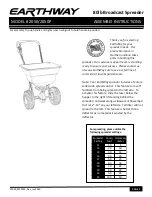
Page 13
PRE OPERATION
UNDERSTAND THE CONTROLS
Rear Gate
The rear gate cylinders are hydraulically controlled
by a tractor spool valve. It is recommended that the
hoses be connected to the tractor so pulling the
spool valve lever back raises the gate and pushing
the valve lever forward closes it. Make it a habit to
connect the hoses the same so the Operator is fa-
miliar with this operation.
Sliding Gate
The unloading belt which moves the sliding gate is
powered by a hydraulic motor and planetary gear-
box. This motor is powered from the tractor
hydraulic system and started and stopped by the
tractor spool valve for the port to which this motor
is connected. It is recommended that the hoses
be connected to the tractor so pulling the spool
valve lever back starts the gate rearward and
pushing the valve lever forward returns the gate to
the front. The gate can be stopped by moving the
spool valve lever to the neutral detent. Make it a
habit to connect the hoses the same so the Opera-
tor is familiar with this operation.
When the sliding gate reaches the rear of the
spreader (see figure 5) it will bear against me-
chanical stops. The tractor hydraulic system will
sense increased hydraulic pressure and return the
spool valve to the neutral OFF position. The same
process occurs when returning the gate to the
front.
Rate Of Application
The rate of application is determined by how fast
the sliding gate and belt (floor) progresses toward
the rear of the spreader. This is regulated by a
manually adjusted flow control valve on the
spreader or a remote adjusted flow control valve in
the tractor. See figure 1.
The remote flow control knob is turned CW to in-
crease the rate and CCW to decrease the rate.
Completely CCW is OFF.
The manual flow control knob should be turned
CW to decrease the rate and CCW to increase the
rate. Completely CW is OFF.
NOTE: If the belt speed is too fast the material will
overload the beaters and cause them to stall and
the warning horn to sound.
Always turn power off when making this adjust-
ment. Start with a slow rate and then increase as
required. Once adjusted, the unloading rate will
remain constant for the same type of material. Fur-
ther application rate adjustment can be obtained
by regulating the tractor ground speed. The appli-
cation rate is not affected by engine RPM.
Spread Pattern
The spread pattern is affected by the speed of the
rotating beaters. The two beater hydraulic motors
are powered independently by a two stage hydrau-
lic pump on the spreader. This pump is powered
by the tractor PTO. The spreader is designed to
give a uniform spread pattern when the tractor
engine is operated at 1000 PTO RPM for typical
materials. Adjustment of the beater speed and
spread pattern is regulated by the engine speed.
TRACTOR DRAWBAR
Set tractor drawbar as shown in figure 2.
FAILURE TO SET DRAWBAR PROPERLY MAY
CAUSE SHAFT TO OVER EXTEND AND SEPA-
RATE OR BEND WHEN CORNERING OR
TRANSPORTING RESULTING IN DEATH OR
PERSONAL INJURY.
Spreaders are available for 1000 RPM drive line
only. Match tractor PTO with the spreader drive
line.
FIGURE 1. FLOW CONTROL
REMOTE FLOW
CONTROL (located
in tractor cab)
MANUAL FLOW
CONTROL (located
on front of spreader)
Содержание Roto-Spread 532-16
Страница 24: ...13 11 4 2 16 1 12 14 3 15 10 5 7 6 8 9 Page 24 532 16 672 20 TRAILER SPREADER ASSEMBLY...
Страница 32: ...9 14 8 17 13 11 16 1 15 6 18 12 20 19 2 12 9 9 10 9 15 1 13 532 672 STANDARD BEATER ASSEMBLY Page 32...
Страница 40: ...HUB WHEEL ASSEMBLY Page 40 26 8 23 25 12 13 16 15 2 24 27 17 4 19 10 18 21 20 14 11 1 9 3 5 7 6 22...














































